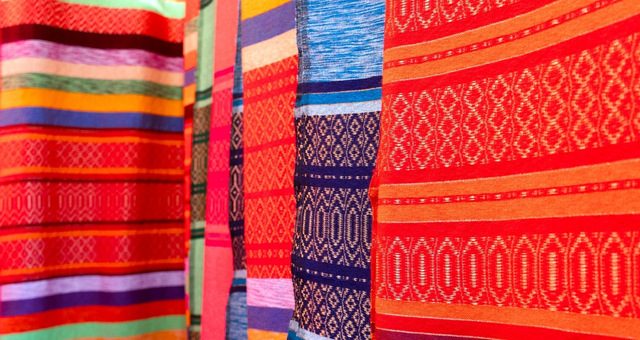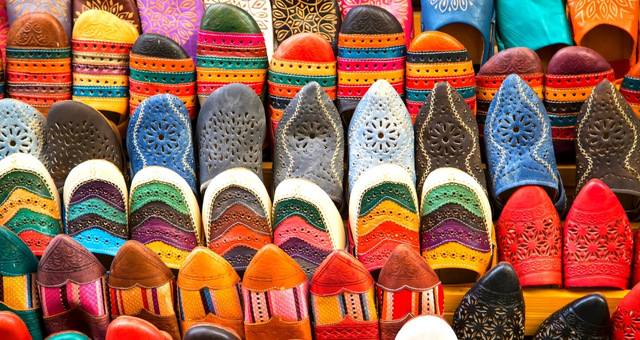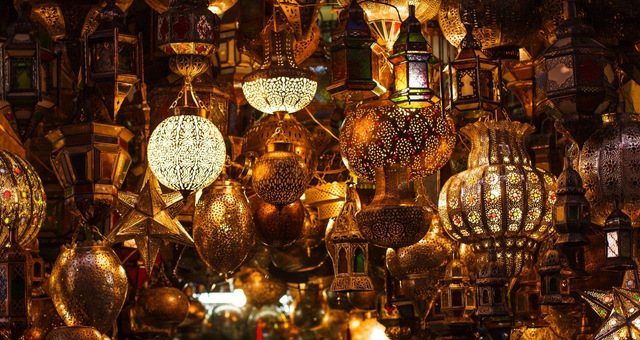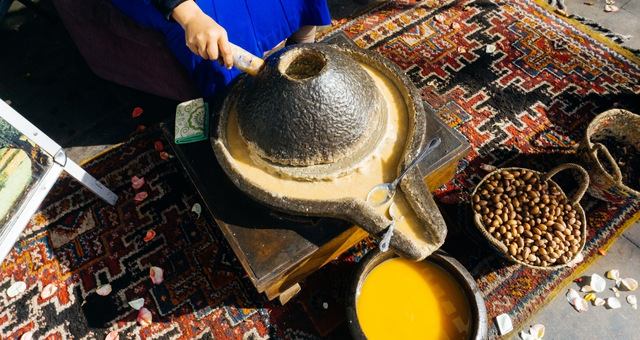Shopping guide: what to buy in Tangier
Shopping is always a good idea!Tangier is the city that will force your hand into adding an extra bag when booking your trip to Morocco. Oh, yes! Prepare to squeeze some hand-painted, artisan goods from leather bags to cotton pajamas, Berber rugs and colorful kaftans into your suitcase.
Find travel tips and information about the currency, the custom checks and limits on goods between Spain and Morocco by ferry. Also, take a look at the shopping list with all the must-have (or at least must-try) items that you can buy in Tangier:
Instructions: for a full Moroccan experience, make sure to have a check on each of these items by the end of your trip😀!

A typical Moroccan tea set
Hand-woven crafts in the weaver’s market
You put your hat and sunglasses on, you’ve got your dirhams (local currency) at hand so we are ready to move! According to our shopping list, we should first have a stop at Fondouk Chejra, also known as “The weaver’s market”.
When you pass through the hole on the wall (yes, literally, there’s a hole) to enter the small market, you will see people weaving wool on giant, 100-year-old looms. There are about 35 little shops of hand-woven crafts such as scarves, pajamas, Rif blankets, throws, and rugs.
Take some time and walk around the stalls next to the old, wooden looms, feel the textures and most importantly observe the art of weaving up close and personal. For the weavers, the Fondouk Chejra market is like home so if they offer you a cup of mint tea, sit with them and enjoy the treat.
Then, you can play the bargaining game for a while as it is part of the Moroccan culture. We couldn’t leave the market unless we bought a stash of these amazing blankets and at least a pair (or two) of soft, cotton pajamas. We couldn’t resist. Can you?
Tip: if you are after an authentic, hand-woven Berber rug we know exactly where to find one (or more). Only 10 minutes from the weaver’s market, you’ll see the Bleu de Fès shop on Hadj Mohamed Torres street.

Colorful, hand-woven rugs in the Fondouk Chejra
Pottery and leather goods in the medina
Now is the time for some leather bags and some shiny, handpainted bowls for your kitchen! Take your beautiful Berber rug and head towards the Boutique Majid. Here, you will find some of the best quality leather products such as traditional Moroccan babouches slippers or bags.
Before continuing your bargain-hunting, you can have a lunch break and try the finger-licking couscous on Kasbah street. After filling your belly, head towards the Bakkali Decor on the same street for all kinds of pottery.
Here, you will find handmade cups, bowls, jewelry boxes, and even coffee tables and mirrors. But the most impressive and most traditional among this colorful sea of ceramics are the tagines (or tajines). Tagine is a traditional Moroccan cooking vessel with a cone-shaped cover, great for making delicious couscous.
Tip: when visiting Tangier during Ramadan, many shops remain closed. In more touristic corners of Tangier, however, you can find plenty of spots for shopping.

Traditional leather slippers (babouches) displayed in the Petit Souk of Tangier
Food and spices in the Souks
Of course, you can’t miss the so-famous Souks of Tangier, the oldest shopping area in the city! Head towards Grand Socco (Big Market) which will lead you through the keyhole gate of Bab Al Fahs to the medina (old town).
It was once a bustling marketplace, filled with traders and bargainers, musicians and artisans. Today, it’s a meeting point with stalls selling fruits, spices, fish, and meat. So, if you’re looking for more, you should visit the Petit Souk (small market).
Follow the streets of Semaine and Siaghine and your steps will take you to the Petit Souk in just 4 minutes. Prepare to surrender your senses to seducing fragrances, hypnotic patterns and strong, spicy flavors. Don't forget to buy some saffron, oregano and cumin that, we have to say, go great with kebab skewers.
Note: should you visit Tangier during Ramadan, we suggest that you do not try out these wonderful delicacies in public out of respect, as Ramadan includes fasting from sunrise to sunset.

Handpainted tagines, traditional Moroccan cooking vessels for a delicious couscous
Luminous lanterns in the old town
Did you always want to have one of these traditional Moroccan lanterns giving this Aladdin vibe? You can find these dreamy lanterns in the old town of Tangier (medina). The aluminum lanterns are cheaper but also easy to bend. Therefore, we recommend you prefer a metal lantern with glass that is more expensive but also of better quality that won’t discolor soon.

Luminous lanterns hanging in the market of Tangier
Argan oil for great skin
Do you know the saying “Self-care isn’t an expense, it’s an investment”? Well, time to invest in some bottles of Morocco’s golden liquid! Argan oil is used for culinary and cosmetic reasons, and it has beneficial properties for your hair, makes your skin silky and smooth, and it even helps with acne and other skin conditions.
Now, where to find it, right? It’s a bit tricky to find 100% pure argan oil as most herbalists tend to mix it with olive oil and spices. If it smells like paprika or turmeric isn’t the real thing so you probably shouldn’t buy it. For real argan oil, supermarkets are the safest option.

Argan oil, the golden liquid of Morocco in the making
Tips for shopping in Tangier
Here you can find 5 useful tips for your shopping therapy in the beautiful city of Tangier:
- The local currency in Morocco is Dirham. You can find many currency exchange services on Mohamed street. However, in most cases, they accept both euros and dollars. It is not recommended to pay in euros, though, as it will cost you more.
- Morocco is still a cash-based economy so it’s probable to find shops that only accept cash, particularly in the open markets and the souks of Tangier.
- Both Tangier Ville and Tanger Med go through immigration and customs control. For more information about the ferry connections from Spain and other European countries to Morocco and the ports of Tangier, read our relevant blog.
- If you want to take lots of goods back home, it is recommended to travel by ferry. Most ferry companies have no limit on luggage allowance and you can always take your car with you. That way, you can fill it with beautifully decorated, handmade rugs, Moroccan ottoman poufs and metal lanterns that can be quite heavy.
- The ferry company of FRS Iberia operating the Tarifa - Tangier Ville ferry connection allows up to 2 pieces with a maximum weight of 20kg per person. However, make sure to check the baggage allowance of your ferry company before your trip as it may be different or change.
Now, take a screenshot of this shopping list or just print the whole guide out and let the seducing markets of Tangier lure you in. Book your ferry tickets at the same price with ferry companies online, download our Ferryhopper App and get ready to mingle with the locals and enjoy lots of fresh mint tea.